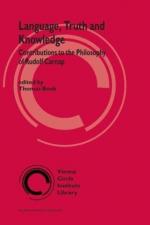|
This section contains 394 words (approx. 2 pages at 300 words per page) |
World of Mathematics on Rudolf Carnap
The German philosopher Rudolf Carnap was born on May 18, 1891, in Ronsdorf, Germany. He died on September 14, 1970, at Santa Monica, California.
Between 1910 and 1914, Carnap studied philosophy, physics and mathematics at the Universities of Jena and Freiburg. During those years, he was particularly interested in physics and the Kantian theory of space. By 1913, he was planning to write his dissertation on thermionic emission based on experimental work. But World War I intervened, and Carnap found himself assigned to the front. But in 1917, he was transferred to Berlin, where Albert Einstein was then professor of physics, and Carnap took advantage of his time in Berlin to study the theory of relativity.
In 1921, when Carnap finally did write his dissertation, he described a philosophical theory of space that showed the influence of Kantian philosophy. It is interesting that Carnap's first and last books both dealt with the philosophy of physics.
In 1926, Carnap relocated to Vienna to become an assistant professor at the University of Vienna. There he met Hans Hahn, Otto Neurath, Kurt Gödel, Ludwig Wittgenstein, and Karl Popper. Carnap became a leading member of the Vienna Circle and, a strong proponent of logical positivism, the philosophy that holds that all valid philosophical problems are solvable by logical analysis.
In 1931, Carnap became professor of natural philosophy at the German University in Prague. With Adolf Hitler's rise to power in 1933, Carnap opted to emigrate and arrived in the United States two years later. He became an American citizen in 1941.
Carnap first became interested in semantics in the 1940s. Later, he also began to look at the structure of scientific theories. According to Carnap, any scientific theory must consist of
- a formal language that included both logical an non-logical terms;
- a set of logical-mathematical axioms and rules of inference;
- a set of non-logical axioms that express the empirical parts of the theory;
- a set of postulates that state the meaning of non-logical terms and formalize the analytical truths of the theory;
- a set of rules that provide an empirical interpretation of the theory.
Except for a short period as a visiting professor at Harvard University (1940-41), Carnap was a member of the faculty at the University of Chicago between 1936 and 1952. From 1952 to 1954, he was a professor at the Institute for Advanced Study at Princeton, and beginning in 1954, a professor at the University of California at Los Angeles.
|
This section contains 394 words (approx. 2 pages at 300 words per page) |


